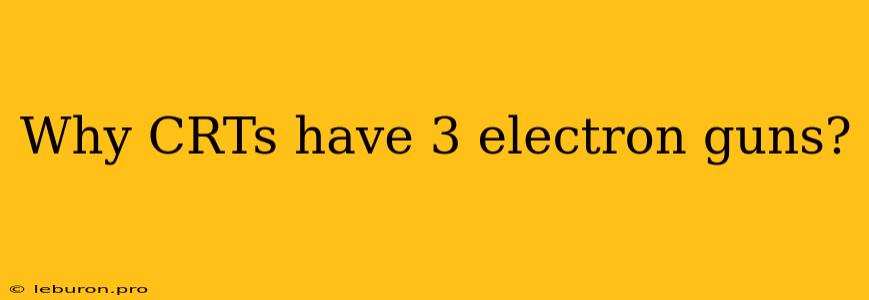The Trifecta of Color: Why CRTs Have 3 Electron Guns
Color television, a ubiquitous part of our lives for decades, relies on a fascinating technology: the cathode ray tube (CRT). While the image itself appears as a seamless blend of colors, the creation of that image is a complex dance of electrons orchestrated by three distinct electron guns. This is the heart of the matter: why CRTs need three electron guns to display a full spectrum of colors. To understand this, we need to dive into the fundamental workings of a CRT and the principles behind color reproduction.
Inside the CRT: A Journey of Electrons
At the core of a CRT lies a vacuum tube with a screen coated in phosphor material. The journey of an image begins with the electron gun, a device that emits a stream of electrons. These electrons are accelerated and focused by a series of electromagnetic fields, forming a narrow beam. This beam is directed towards the screen, where it interacts with the phosphor coating.
The Key to Color: Phosphor Triads
The crucial element here is the phosphor coating. It's not a single material but a composite of different phosphors arranged in triads. Each triad consists of three phosphors, typically red, green, and blue. When the electron beam strikes a particular triad, it excites the corresponding phosphor, causing it to emit light.
The Significance of Three Electron Guns
Now, let's connect the dots. Each electron gun is specifically designed to target one of the phosphors in a triad. One gun generates a beam of electrons that excites the red phosphor, another excites the green phosphor, and the third excites the blue phosphor. The intensity of each beam can be controlled independently, allowing for precise color mixing.
The Science of Color Reproduction
This ability to control the intensity of each electron beam forms the foundation of color reproduction in CRTs. By varying the intensity of the red, green, and blue beams, the CRT can create a wide spectrum of colors. This concept is rooted in the principle of additive color mixing. In additive color mixing, combining red, green, and blue light in varying proportions allows us to create a vast range of colors.
The Benefits of Three Electron Guns
The use of three electron guns in CRTs delivers several key benefits:
- High Brightness: The dedicated electron guns ensure that each phosphor receives an optimal amount of energy, resulting in brighter and more vibrant images.
- Wide Color Gamut: The ability to control the intensity of each color independently allows for a wider range of colors to be displayed.
- Precise Color Mixing: The separate electron guns enable precise control over color mixing, ensuring accurate representation of subtle shades and hues.
Beyond the CRT: The Legacy Continues
While CRT technology has largely been superseded by flat-screen displays, the fundamental principles of color reproduction remain relevant. Modern displays, including LCDs and OLEDs, still leverage the concept of additive color mixing, albeit through different mechanisms. The legacy of the three electron guns lives on in the fundamental understanding of color technology and the principles that continue to shape the visual experience.
In conclusion, the use of three electron guns in CRTs is a testament to the intricate workings of color television. This system, rooted in the principles of additive color mixing, allowed CRTs to create vibrant and accurate images for decades. While CRT technology has evolved, the foundation it laid in understanding color reproduction remains relevant, paving the way for the advanced displays we enjoy today.
